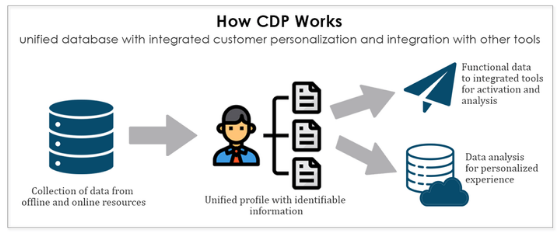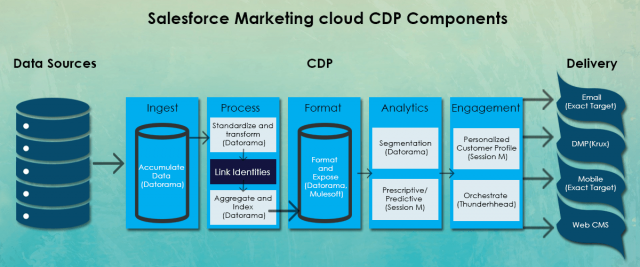In this technology-driven world where data is considered as the oil for market and company mechanism, technology is advancing towards more customer-centric solutions. Data is and will be considered the driving force whether it’s from an offline or online source, segmented according to the channels or available in a different environment. Now companies are inclined towards personalization of customer data which will result in better marketing approaches towards prospective customers and to tend current customers in the best possible method.
We already had Customer Relationship Management (CRM) and Data Management Platform (DMP) for the purpose of engaging customer data and the newest entrant in this field is the Customer Data Platform (CDP). As both CRM and CDP start with the customer, there is a bit confused between the two as CDP was regarded as an extension of CRM. As the market evolved with the usage of CDP, the confusion between CRM and CDP has been cleared. We are going to be more elaborative on CDP in this blog as this is the new tool which is considered as the latest fad in mark tech.
What is Customer Data Platform and its functions?
As per Customer Data Platform Institute, CDP is defined as a packaged system that builds a unified, persistent customer database that’s accessible by other systems. CDP functionality involves gathering data from multiple sources and providing insights for marketing decisions involving existing customers and prospects.
In layman terms, what we are looking at is the evolution of Data Management where data can be integrated from various resources in real-time and can be used for analytics and insights. CDP comes with the advantage of the personalization of customer data where they can be identified individually. Personalized identification helps companies to identify the preferences, personalize the overall experience resulting in better customer service at a faster rate.
CDP works on Personally Identifiable Information (PII) which is the process of identifying a specific individual through identifiable information collected through data from various resources. CDP predecessor Data Management Platform lacked this functionality as it worked on cookies-based data. CDP was created to break the shackles concerning audience identification as CDP holds the advantage of real-time data collection. The personalization AI/ML in CDP is used for tracking individuals as well as sources.
Key Component/Capabilities of CDP
1. Data ingestion and integration
CDP accumulates data in real-time from online and offline resources and through data connectors and ML insights provide the same to other integrated tools for decision making. CDP engages event-level data (data collected throughout the customer journey) behavioral data of the customer, demographic data, and the transactional level activity data. CDP converts the same to campaign and engagement metrics which leads to better customer service and modeled data structure.
2. Real-time segmentation
CDP functions on a real-time basis which means the organization can provide customer-centric solutions and services at any given point of the customer journey. CDP is used for collecting customer data in real-time and provide personalized Omni Channel Marketing (Acquisition, Engagement, and Retention). For example, a tele caller through the help of CDP, can provide the customer on call a tailored deal and inform future events related to customer preferences.
3. Customer profile management
CDP works on PII (Personally identifiable information) which helps in creating a universal and persistent customer profile. Identifiable customer id can be built based on known or unknown identifiers like cookies, email addressed and social account behaviors. CDP analyzes behaviors, the lifecycle of the customer journey, content affinity and creates predictive indicators to enhance personalization of customer data.
4. Analytics through AI/ML
CDP develops predictive/prescriptive analytics and optimize the same through inbuilt ML insights. Companies desire to utilize analytics which is spanned across email campaigns to social media engagements and website visits to existing data in CRM. CDP provides one-stop for the analytics of all the data scattered across platforms and ties them together to give a comprehensive picture of customer data. Recommendation is an integral part of CDP where context is given to customer data for actionable objects.

How is Customer Data Platform different from Data Management Platform
DMP (Data management platform) is the old warhorse, since the initial days when marketing technology attained the stage of automation, DMP stood its ground for the basic framework. The basic difference between both the tools is based on analytical and data processing aspects
1. DMP works on collecting 3rd party data and analyses the same for further marketing usage. CDP consolidates all types of data i.e. online (web behavior of the customer) and offline (CRM data and cookies) which gives it a broader spectrum to work on.
2. DMP’s basic function is based on cookies and ads-oriented data which translates into the segment and age-specific targeting. CDP took lead from DMP in the form of better data utilization on a real-time basis and eliminating the 90 days data expiration clause.
3. DMP lacked in personalization factor as the data segments are cookies based and hence create prebuilt audiences as compared to CDP where data is personally segmented through Personally Identifiable Information (PII).
4. DMP also lacks in the predictive analysis due to the absence of AI/ML and is not feasible when it comes to complex and futuristic marketing decisions. CDP with the help of inbuilt AI/ML insights provides the ability to send campaigns on a real-time basis for example customized mails at the time of purchase by the customer.
How is Customer Data Platform different from Customer Relationship Management
CRM as we already know enables customer handling teams (sales, customer, support) to manage customer relationships through the available sets of customer data. CDP holds the edge over CRM through better data collection and the analytics provided on the segmented data.
1. CRM is mostly operational in nature as it relies on direct inputs of customer data whereas CDP is mostly analytical where data is collected, analyzed, and distributed to integrated tools.
2. CRM helps teams to capture, track, and manage details but it lacks in the personalization on the identifiable basis and data analysis. CDP covers up the plug holes left by CRM through PII and distribution of data to all integrated tools.
3. CRM is created to manage and engage potential and existing customers. CDP is created as the next step in data accumulation and as an analytical tool for accumulated data.
4. CRM is uni-dimensional as the data input is a profile card type where the information is limited in nature. CDP is the multi-dimensional tool that not only provides flexibility in data collection but also converts that data in actionable objects.
Salesforce Plans for CDP
Salesforce has already started to expand the territory in CDP through acquisitions and investments in key CDP companies and is finally integrating the concept as Salesforce Customer 360 Truth. Salesforce acquired Dataroma and its nearest rival Tableau in 2018 with the concept of integrating the CDP in Exact Target (Salesforce Marketing Cloud) for enhanced marketing journeys. In the year 2020, Salesforce acquired Evergage, a blue blood CDP platform company. The investment in Session M was intended to personalize the data collected and enhance the predictive analysis. Salesforce CDP components were stacked in this manner.

Salesforce through Salesforce Customer 360 Truth intends to incorporate the available CDP mechanism for enhanced data capturing and data utilizations across the clouds.
The focus is not to limit CDP functionality to marketing only but to make the data available for Sales, Service, and Commerce. Unified customer profiles can be accessed across Salesforce organizations and the insights can be utilized by the company throughout the customer journey of individual customers.
Salesforce Customer 360 truth comprises new capabilities like Customer 360 Audiences, which extends the Customer 360 Data Manager to provide real-time data integration and segmentation of data across all channels. Salesforce CDP functionalities have been increased by providing a single interface for the centralization of data, segmentation, personalization of customer data, and analytics/insights with the help of Einstein AI.
CDP can be treated as a trendsetter in marketing tech, but we must consider that it is a part of evolution rather than revolution as the blueprint was always there in the form of a CRM and DMP. CDP has enhanced how we treat and utilize the most precious commodity in today’s technology-driven world. Hopefully, the advancement will lead to a hassle-free and unified data-driven world.
Leave A Comment